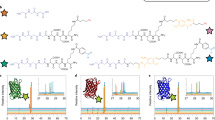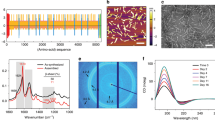Abstract
Biomaterials exhibiting precise ratios of different bioactive protein components are critical for applications ranging from vaccines to regenerative medicine, but their design is often hindered by limited choices and cross-reactivity of protein conjugation chemistries. Here, we describe a strategy for inducing multiple different expressed proteins of choice to assemble into nanofibres and gels with exceptional compositional control. The strategy employs ‘βTail’ tags, which allow for good protein expression in bacteriological cultures, yet can be induced to co-assemble into nanomaterials when mixed with additional β-sheet fibrillizing peptides. Multiple different βTail fusion proteins could be inserted into peptide nanofibres alone or in combination at predictable, smoothly gradated concentrations, providing a simple yet versatile route to install precise combinations of proteins into nanomaterials. The technology is illustrated by achieving precisely targeted hues using mixtures of fluorescent proteins, by creating nanofibres bearing enzymatic activity, and by adjusting antigenic dominance in vaccines.
This is a preview of subscription content, access via your institution
Access options
Subscribe to this journal
Receive 12 print issues and online access
$259.00 per year
only $21.58 per issue
Buy this article
- Purchase on Springer Link
- Instant access to full article PDF
Prices may be subject to local taxes which are calculated during checkout





Similar content being viewed by others
References
Baxa, U., Speransky, V., Steven, A. C. & Wickner, R. B. Mechanism of inactivation on prion conversion of the Saccharomyces cerevisiae Ure2 protein. Proc. Natl Acad. Sci. USA 99, 5253–5260 (2002).
Leng, Y. et al. Integration of a fluorescent molecular biosensor into self-assembled protein nanowires: A large sensitivity enhancement. Angew. Chem. Int. Ed. 49, 7243–7246 (2010).
Men, D. et al. Seeding-induced self-assembling protein nanowires dramatically increase the sensitivity of immunoassays. Nano Lett. 9, 2246–2250 (2009).
Baldwin, A. J. et al. Cytochrome display on amyloid fibrils. J. Am. Chem. Soc. 128, 2162–2163 (2006).
Horii, A., Wang, X., Gelain, F. & Zhang, S. Biological designer self-assembling peptide nanofiber scaffolds significantly enhance osteoblast proliferation, differentiation and 3-D migration. PLoS ONE 2, e190 (2007).
Wang, Y. et al. Peptide nanofibers preconditioned with stem cell secretome are renoprotective. J. Am. Soc. Nephrol. 22, 704–717 (2011).
Matson, J. B. & Stupp, S. I. Drug release from hydrazone-containing peptide amphiphiles. Chem. Commun. 47, 7962–7964 (2011).
Veiga, A. S. et al. Arginine-rich self-assembling peptides as potent antibacterial gels. Biomaterials 33, 8907–8916 (2012).
Black, M. et al. Self-assembled peptide amphiphile micelles containing a cytotoxic T-cell epitope promote a protective immune response in vivo. Adv. Mater. 24, 3845–3849 (2012).
Hudalla, G. A. et al. A self-adjuvanting supramolecular vaccine carrying a folded protein antigen. Adv. Healthc. Mater. 2, 1114–1119 (2013).
Rudra, J. S., Tian, Y. F., Jung, J. P. & Collier, J. H. A self-assembling peptide acting as an immune adjuvant. Proc. Natl Acad. Sci. USA 107, 622–627 (2010).
Collier, J. H., Rudra, J. S., Gasiorowski, J. Z. & Jung, J. P. Multi-component extracellular matrices based on peptide self-assembly. Chem. Soc. Rev. 39, 3413–3424 (2010).
Woolfson, D. N. & Mahmoud, Z. N. More than just bare scaffolds: Towards multi-component and decorated fibrous biomaterials. Chem. Soc. Rev. 39, 3464–3479 (2010).
Cui, H., Webber, M. J. & Stupp, S. I. Self-assembly of peptide amphiphiles: From molecules to nanostructures to biomaterials. Biopolymers 94, 1–18 (2010).
Brodin, J. D. et al. Metal-directed, chemically tunable assembly of one-, two- and three-dimensional crystalline protein arrays. Nature Chem. 4, 375–382 (2012).
King, N. P. et al. Computational design of self-assembling protein nanomaterials with atomic level accuracy. Science 336, 1171–1174 (2012).
Sinclair, J. C., Davies, K. M., Venien-Bryan, C. & Noble, M. E. Generation of protein lattices by fusing proteins with matching rotational symmetry. Nature Nanotech. 6, 558–562 (2011).
Sangiambut, S. et al. A robust route to enzymatically functional, hierarchically self-assembled peptide frameworks. Adv. Mater. 25, 2661–2665 (2013).
Kim, W. et al. A high-throughput screen for compounds that inhibit aggregation of the Alzheimer’s peptide. ACS Chem. Biol. 1, 461–469 (2006).
Wu, W., Xing, L., Zhou, B. & Lin, Z. Active protein aggregates induced by terminally attached self-assembling peptide ELK16 in Escherichia coli. Microb. Cell Fact. 10, 9 (2011).
Collier, J. H. & Messersmith, P. B. Enzymatic modification of self-assembled peptide structures with tissue transglutaminase. Bioconjug. Chem. 14, 748–755 (2003).
Pagel, K. et al. How metal ions affect amyloid formation: Cu2+- and Zn2+-sensitive peptides. ChemBioChem 9, 531–536 (2008).
Jung, J. P., Moyano, J. V. & Collier, J. H. Multifactorial optimization of endothelial cell growth using modular synthetic extracellular matrices. Integr. Biol. 3, 185–196 (2011).
Jung, J. P. et al. Co-assembling peptides as defined matrices for endothelial cells. Biomaterials 30, 2400–2410 (2009).
Marini, D. M., Hwang, W., Lauffenburger, D. A., Zhang, S. & Kamm, R. D. Left-handed helical ribbon intermediates in the self-assembly of a β-sheet peptide. Nano Lett. 2, 295–299 (2002).
Zhang, S. et al. Self-complementary oligopeptide matrices support mammalian cell attachment. Biomaterials 16, 1385–1393 (1995).
Takahashi, Y., Ueno, A. & Mihara, H. Heterogeneous assembly of complementary peptide pairs into amyloid fibrils with α–β structural transition. ChemBioChem 2, 75–79 (2001).
Kolattukudy, P. E., Purdy, R. E. & Maiti, I. B. in Methods in Enzymology Vol. 71 (ed Lowenstein John, M.) 652–664 (Academic, 1981).
Chen, J. et al. The use of self-adjuvanting nanofiber vaccines to elicit high-affinity B cell responses to peptide antigens without inflammation. Biomaterials 34, 8776–8785 (2013).
Malyala, P. & Singh, M. Endotoxin limits in formulations for preclinical research. J. Pharm. Sci. 97, 2041–2044 (2008).
Acknowledgements
This research was supported by the National Institutes of Health (NIBIB, 1R01EB009701; NCI, U54 CA151880; NIAID, 1F32AI096769 and 5R21AI09444), the Chicago Biomedical Consortium with support from the Searle Funds at the Chicago Community Trust, and the National Science Foundation (CHE-0802286). The content is solely the responsibility of the authors and does not necessarily represent the official views of the National Institute of Biomedical Imaging and BioEngineering, the National Institute of Allergy and Infectious Disease, the National Cancer Institute, or the National Institutes of Health.
Author information
Authors and Affiliations
Contributions
J.H.C. directed the work, designed experiments, analysed the data and wrote the paper. G.A.H. designed experiments, conducted experiments, analysed the data and wrote the paper. T.S., J.Z.G., Y.F.T. and H.H. performed experiments and analysed the results. A.S.C. designed experiments and analysed data.
Corresponding author
Ethics declarations
Competing interests
J.H.C. and G.A.H. are named as inventors on a patent application filed by the University of Chicago (US Patent Application No. 14/209,757, ‘Methods and compositions involving fibrillizing polypeptides for nanofibers’) that covers the technology described in this paper.
Supplementary information
Supplementary Information
Supplementary Information (PDF 1959 kb)
Rights and permissions
About this article
Cite this article
Hudalla, G., Sun, T., Gasiorowski, J. et al. Gradated assembly of multiple proteins into supramolecular nanomaterials. Nature Mater 13, 829–836 (2014). https://doi.org/10.1038/nmat3998
Received:
Accepted:
Published:
Issue Date:
DOI: https://doi.org/10.1038/nmat3998
This article is cited by
-
Accelerating the prediction and discovery of peptide hydrogels with human-in-the-loop
Nature Communications (2023)
-
Advances in nanomaterial vaccine strategies to address infectious diseases impacting global health
Nature Nanotechnology (2021)
-
Intracellular artificial supramolecules based on de novo designed Y15 peptides
Nature Communications (2021)
-
HIV envelope antigen valency on peptide nanofibers modulates antibody magnitude and binding breadth
Scientific Reports (2021)
-
Efficient protein incorporation and release by a jigsaw-shaped self-assembling peptide hydrogel for injured brain regeneration
Nature Communications (2021)



